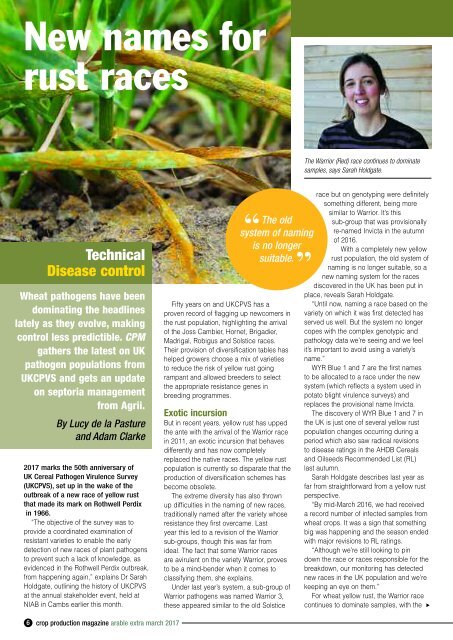In this issue..
CPM-March-Extra-2017
CPM-March-Extra-2017
Create successful ePaper yourself
Turn your PDF publications into a flip-book with our unique Google optimized e-Paper software.
New names for<br />
rust races<br />
The Warrior (Red) race continues to dominate<br />
samples, says Sarah Holdgate.<br />
Technical<br />
Disease control<br />
Wheat pathogens have been<br />
dominating the headlines<br />
lately as they evolve, making<br />
control less predictible. CPM<br />
gathers the latest on UK<br />
pathogen populations from<br />
UKCPVS and gets an update<br />
on septoria management<br />
from Agrii.<br />
By Lucy de la Pasture<br />
and Adam Clarke<br />
2017 marks the 50th anniversary of<br />
UK Cereal Pathogen Virulence Survey<br />
(UKCPVS), set up in the wake of the<br />
outbreak of a new race of yellow rust<br />
that made its mark on Rothwell Perdix<br />
in 1966.<br />
“The objective of the survey was to<br />
provide a coordinated examination of<br />
resistant varieties to enable the early<br />
detection of new races of plant pathogens<br />
to prevent such a lack of knowledge, as<br />
evidenced in the Rothwell Perdix outbreak,<br />
from happening again,” explains Dr Sarah<br />
Holdgate, outlining the history of UKCPVS<br />
at the annual stakeholder event, held at<br />
NIAB in Cambs earlier <strong>this</strong> month.<br />
The old<br />
system of naming<br />
is no longer<br />
suitable.<br />
“<br />
”<br />
Fifty years on and UKCPVS has a<br />
proven record of flagging up newcomers in<br />
the rust population, highlighting the arrival<br />
of the Joss Cambier, Hornet, Brigadier,<br />
Madrigal, Robigus and Solstice races.<br />
Their provision of diversification tables has<br />
helped growers choose a mix of varieties<br />
to reduce the risk of yellow rust going<br />
rampant and allowed breeders to select<br />
the appropriate resistance genes in<br />
breeding programmes.<br />
Exotic incursion<br />
But in recent years, yellow rust has upped<br />
the ante with the arrival of the Warrior race<br />
in 2011, an exotic incursion that behaves<br />
differently and has now completely<br />
replaced the native races. The yellow rust<br />
population is currently so disparate that the<br />
production of diversification schemes has<br />
become obsolete.<br />
The extreme diversity has also thrown<br />
up difficulties in the naming of new races,<br />
traditionally named after the variety whose<br />
resistance they first overcame. Last<br />
year <strong>this</strong> led to a revision of the Warrior<br />
sub-groups, though <strong>this</strong> was far from<br />
ideal. The fact that some Warrior races<br />
are avirulent on the variety Warrior, proves<br />
to be a mind-bender when it comes to<br />
classifying them, she explains.<br />
Under last year’s system, a sub-group of<br />
Warrior pathogens was named Warrior 3,<br />
these appeared similar to the old Solstice<br />
race but on genotyping were definitely<br />
something different, being more<br />
similar to Warrior. It’s <strong>this</strong><br />
sub-group that was provisionally<br />
re-named <strong>In</strong>victa in the autumn<br />
of 2016.<br />
With a completely new yellow<br />
rust population, the old system of<br />
naming is no longer suitable, so a<br />
new naming system for the races<br />
discovered in the UK has been put in<br />
place, reveals Sarah Holdgate.<br />
“Until now, naming a race based on the<br />
variety on which it was first detected has<br />
served us well. But the system no longer<br />
copes with the complex genotypic and<br />
pathology data we’re seeing and we feel<br />
it’s important to avoid using a variety’s<br />
name.”<br />
WYR Blue 1 and 7 are the first names<br />
to be allocated to a race under the new<br />
system (which reflects a system used in<br />
potato blight virulence surveys) and<br />
replaces the provisional name <strong>In</strong>victa.<br />
The discovery of WYR Blue 1 and 7 in<br />
the UK is just one of several yellow rust<br />
population changes occurring during a<br />
period which also saw radical revisions<br />
to disease ratings in the AHDB Cereals<br />
and Oilseeds Recommended List (RL)<br />
last autumn.<br />
Sarah Holdgate describes last year as<br />
far from straightforward from a yellow rust<br />
perspective.<br />
“By mid-March 2016, we had received<br />
a record number of infected samples from<br />
wheat crops. It was a sign that something<br />
big was happening and the season ended<br />
with major revisions to RL ratings.<br />
“Although we’re still looking to pin<br />
down the race or races responsible for the<br />
breakdown, our monitoring has detected<br />
new races in the UK population and we’re<br />
keeping an eye on them.”<br />
For wheat yellow rust, the Warrior race<br />
continues to dominate samples, with the<br />
▲<br />
6 crop production magazine arable extra march 2017


